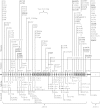Genotype and phenotype correlations in 417 children with congenital hyperinsulinism
- PMID: 23275527
- PMCID: PMC3565119
- DOI: 10.1210/jc.2012-2169
Genotype and phenotype correlations in 417 children with congenital hyperinsulinism
Abstract
Context: Hypoglycemia due to congenital hyperinsulinism (HI) is caused by mutations in 9 genes.
Objective: Our objective was to correlate genotype with phenotype in 417 children with HI.
Methods: Mutation analysis was carried out for the ATP-sensitive potassium (KATP) channel genes (ABCC8 and KCNJ11), GLUD1, and GCK with supplemental screening of rarer genes, HADH, UCP2, HNF4A, HNF1A, and SLC16A1.
Results: Mutations were identified in 91% (272 of 298) of diazoxide-unresponsive probands (ABCC8, KCNJ11, and GCK), and in 47% (56 of 118) of diazoxide-responsive probands (ABCC8, KCNJ11, GLUD1, HADH, UCP2, HNF4A, and HNF1A). In diazoxide-unresponsive diffuse probands, 89% (109 of 122) carried KATP mutations; 2% (2 of 122) had GCK mutations. In mutation-positive diazoxide-responsive probands, 42% were GLUD1, 41% were dominant KATP mutations, and 16% were in rare genes (HADH, UCP2, HNF4A, and HNF1A). Of the 183 unique KATP mutations, 70% were novel at the time of identification. Focal HI accounted for 53% (149 of 282) of diazoxide-unresponsive probands; monoallelic recessive KATP mutations were detectable in 97% (145 of 149) of these cases (maternal transmission excluded in all cases tested). The presence of a monoallelic recessive KATP mutation predicted focal HI with 97% sensitivity and 90% specificity.
Conclusions: Genotype to phenotype correlations were most successful in children with GLUD1, GCK, and recessive KATP mutations. Correlations were complicated by the high frequency of novel missense KATP mutations that were uncharacterized, because such defects might be either recessive or dominant and, if dominant, be either responsive or unresponsive to diazoxide. Accurate and timely prediction of phenotype based on genotype is critical to limit exposure to persistent hypoglycemia in infants and children with congenital HI.
Figures

Similar articles
-
Clinical and genetic characterization of congenital hyperinsulinism in Spain.Eur J Endocrinol. 2016 Jun;174(6):717-26. doi: 10.1530/EJE-16-0027. Eur J Endocrinol. 2016. PMID: 27188453
-
Clinical and molecular characterisation of 300 patients with congenital hyperinsulinism.Eur J Endocrinol. 2013 Mar 15;168(4):557-64. doi: 10.1530/EJE-12-0673. Print 2013 Apr. Eur J Endocrinol. 2013. PMID: 23345197 Free PMC article.
-
Mutational analysis of ABCC8, KCNJ11, GLUD1, HNF4A and GCK genes in 30 Chinese patients with congenital hyperinsulinism.Endocr J. 2014;61(9):901-10. doi: 10.1507/endocrj.ej13-0398. Epub 2014 Jul 8. Endocr J. 2014. PMID: 25008049
-
Hyperinsulinism in infancy--genetic aspects.Pediatr Endocrinol Rev. 2006 Aug;3 Suppl 3:521-6. Pediatr Endocrinol Rev. 2006. PMID: 17551476 Review.
-
Perspective on the Genetics and Diagnosis of Congenital Hyperinsulinism Disorders.J Clin Endocrinol Metab. 2016 Mar;101(3):815-26. doi: 10.1210/jc.2015-3651. Epub 2016 Feb 23. J Clin Endocrinol Metab. 2016. PMID: 26908106 Free PMC article. Review.
Cited by
-
Clinical management of diazoxide-unresponsive congenital hyperinsulinism: A single-center experience.Clin Pediatr Endocrinol. 2024;33(3):187-194. doi: 10.1297/cpe.2024-0004. Epub 2024 Jun 3. Clin Pediatr Endocrinol. 2024. PMID: 38993725 Free PMC article.
-
Case report: Exceptional transmission of congenital hyperinsulinism from a focal CHI mother to her diffuse CHI dichorionic diamniotic twins.Front Endocrinol (Lausanne). 2024 Jun 17;15:1408003. doi: 10.3389/fendo.2024.1408003. eCollection 2024. Front Endocrinol (Lausanne). 2024. PMID: 38952388 Free PMC article.
-
Congenital Hyperinsulinaemic Hypoglycaemia-A Review and Case Presentation.J Clin Med. 2022 Oct 12;11(20):6020. doi: 10.3390/jcm11206020. J Clin Med. 2022. PMID: 36294341 Free PMC article. Review.
-
A loss-of-function mutation in KCNJ11 causing sulfonylurea-sensitive diabetes in early adult life.Diabetologia. 2024 May;67(5):940-951. doi: 10.1007/s00125-024-06103-w. Epub 2024 Feb 17. Diabetologia. 2024. PMID: 38366195 Free PMC article.
-
Surgical treatment of congenital hyperinsulinism: Results from 500 pancreatectomies in neonates and children.J Pediatr Surg. 2019 Jan;54(1):27-32. doi: 10.1016/j.jpedsurg.2018.10.030. Epub 2018 Oct 5. J Pediatr Surg. 2019. PMID: 30343978 Free PMC article.
References
-
- Stanley CA, DeLeon DD, eds. 2012. Monogenic Hyperinsulinemic Hypoglycemia Disorders. Basel, Switzerland: Karger
-
- Aguilar-Bryan L, Nichols CG, Wechsler SW, et al. Cloning of the β cell high-affinity sulfonylurea receptor: a regulator of insulin secretion. Science. 1995;268:423–426 - PubMed
-
- Thomas PM, Cote GJ, Wohllk N, et al. Mutations in the sulfonylurea receptor gene in familial persistent hyperinsulinemic hypoglycemia of infancy. Science. 1995;268:426–429 - PubMed
-
- Nestorowicz A, Inagaki N, Gonoi T, et al. A nonsense mutation in the inward rectifier potassium channel gene, Kir6.2, is associated with familial hyperinsulinism. Diabetes. 1997;46:1743–1748 - PubMed
-
- Nestorowicz A, Wilson BA, Schoor KP, et al. Mutations in the sulonylurea receptor gene are associated with familial hyperinsulinism in Ashkenazi Jews. Hum Mol Genet. 1996;5:1813–1822 - PubMed
Publication types
MeSH terms
Substances
Grants and funding
LinkOut - more resources
Full Text Sources
Other Literature Sources
Medical
Molecular Biology Databases
Miscellaneous

